
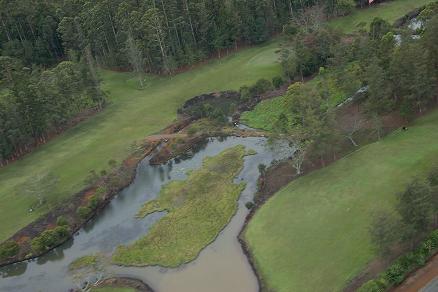
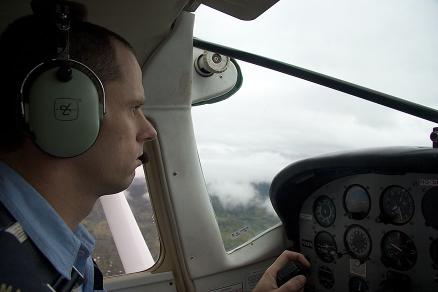
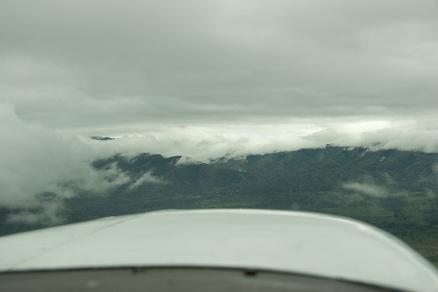
A new day dawns, and deja vu beckons in the form of a Cessna 206 and an early
morning flight to Kol. Same passengers, but today the pilot is Clint. The cloud base has some breaks, but is fairly extensive, and to my relief the kamikaze kites are nowhere to be seen on the runway. As we take off, we get a birds eye view of Hagen golf course. No trouble keeping the water hazards full, I suspect.




Today we avoid the Kimil gap because of the cloud, and instead take a more roundabout route. The adjoining valley is suprisingly clear of cloud (this often happens, I'm told, that one valley can be completely clouded in, and the next is clear). This valley seems to be more rugged,
and less populated.
Again, rugged ridges, rivers, small settlements on ridgetops (easier to defend from attacking tribes - you may think
I'm kidding, but I'm not), cleared areas on the steep slopes etc.
The cockroach doesn't make an appearance today. Must be too early for it.




We climb higher, and float above a sea of white cloud, with various mountains
rising up above the cloud like islands. Directly ahead we can see Mt Wilhelm, tallest mountain in PNG, at 14,600 feet. This is over a mile above our current altitude, giving an idea just how high that mountain is.
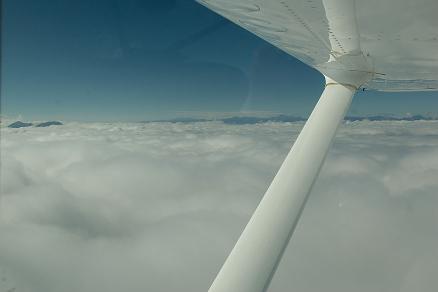
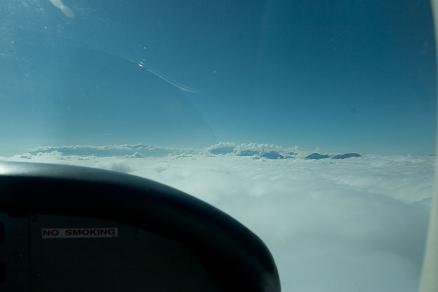
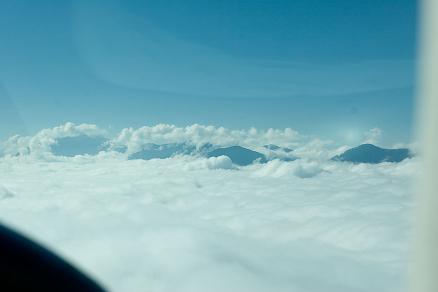
As we approach the highland valley where Kol sits, Clint starts to look for breaks in the cloud
so that we can descend into the valley. It's only scattered cloud, so good visibility (gee, I think I'm starting to think like a pilot :-)
The village of Kol has a number of buildings, and has a health centre, a primary and secondary school, and various other mission supported resources. It is situated beside what looks like a fast flowing mountain river.
He does a circuit of the village, looking for pigs and other obstacles on the runway, and
we make our descent to the bush runway. Meanwhile, people are running to the runway, and gathering below.
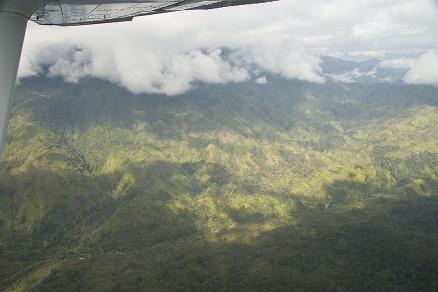
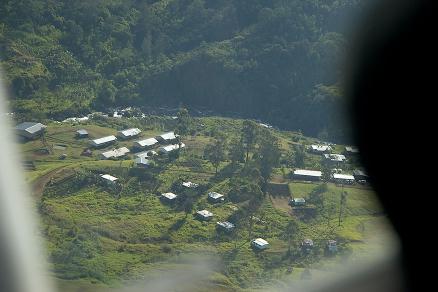
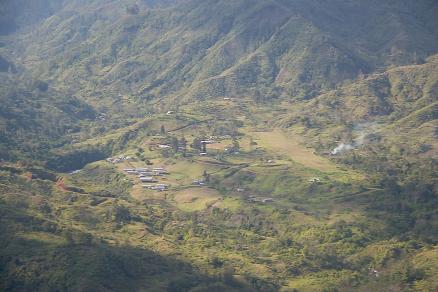

A surprisingly smooth landing, given the rough runway (I've experienced worse in a 747), and there is a crowd of over a hundred gathered to watch the plane taxi in.
The passengers are greeted as long lost family, with an older grandmother seeing the
baby for the first time (the emotion is palpable).
Crowds of children and youths gather for photos, and scream with delight when I
show them their faces on the camera LCD. They are very friendly, ingenuous, and open people, quite different from the townfolk, just as everyone has been telling me.

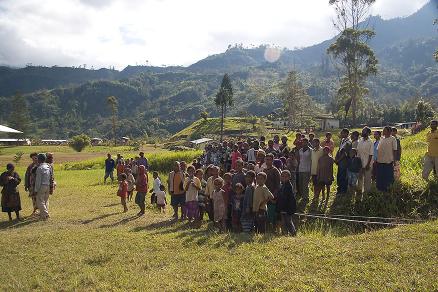
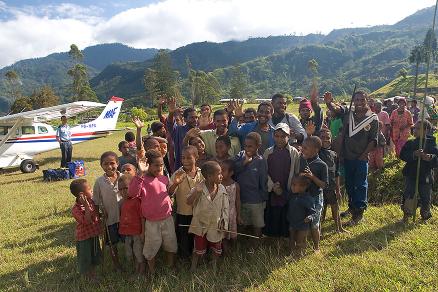

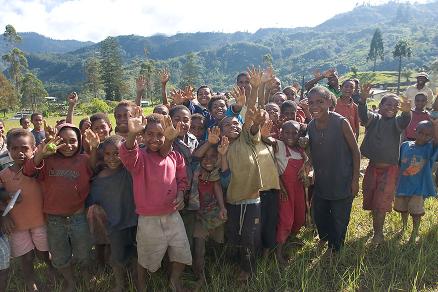
The MAF plane is obviously seen as a welcome and looked-for sight in this village.
There used to be a track to the village years ago, but poor maintenance has meant
that this track is now completely impassable by vehicle, so the only way out is either a
full day's walk to the Waghi Valley over a mountain pass, or via the MAF plane. Given the look
of the mountains around the village, today I'll choose the plane (though if I had the time...)
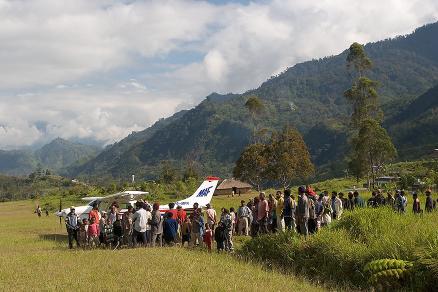


The returning chap is seen as a `big man',
or someone from the village who has made good (ran a construction outfit in Hagen), and is
now a man of influence and standing. He offers to show me around the village, and he explains he
is back to fund an Independence Day celebration (continually telling me how much he is
paying for it). Nationals are not really subtle or humble when it comes to understanding
prestige or influence, and it's very much a tribal attitude of power broking. This may be why
there are such problems when it comes to politics and government authority.
He offers to take me down to a part of the village, where there are number of huts and the local church (the building with the old can hanging on it, as a gathering bell).
Crowds of kids mingle around us, and people want to shake your hand and greet you.
It helps that Clint speaks very good Pidgin, and a couple of the locals have good English.
The huts are right next to the airstrip (the drainage ditch you can see in the photo is on the edge of the runway), and
banana trees are growing throughout the vegetable gardens surrounding the huts.
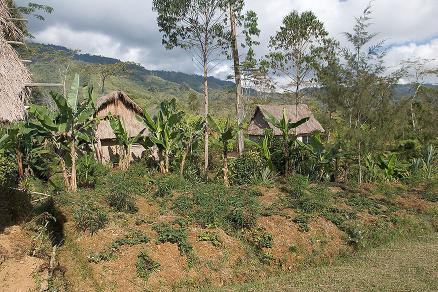
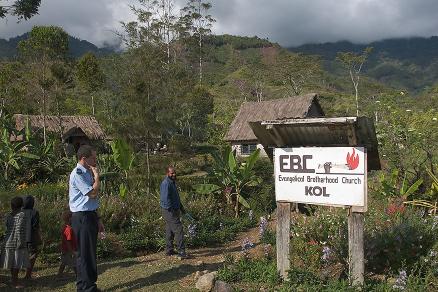
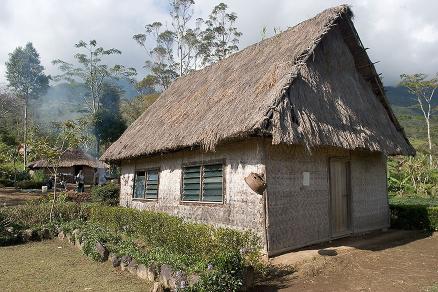
In the space between the church and the huts, a special meal
called a `mumu' is being prepared,
similar to a Maori Hangi, where a dismembered pig is cooked using heated rocks in
a ground pit. The pig is being butchered on banana leaves, and a nearby fire is heating the rocks, along with a bag made of banana leaves containing the pig's blood (essentially
making black pudding). A real delicacy, I hear. Shame I can't stay long enough to enjoy that
particular epicurean delight, but unfortunately my peanut butter sandwiches are waiting for me
back at the MAF base.



I spy some out of place objects (besides myself and Clint) near one of the huts; a solar
panel and a radio mast. In the absence of any other communication, radio is a common
method to keep in contact with the rest of the world, being used for anything from
talking with relatives to summoning emergency medical aid. My friends at CRMF are very
instrumental in installing these kinds of radio kits throughout the whole of PNG.
This is an essential tool to connect these remote communities. Who knows, one day it may
be a minature sat dish running the Internet, bringing distance education, email and all those
other things we take for granted.

I am shown the interior of one the huts (a well-off one, since it has a mattress), and it
strikes me just how simply these people live, and yet seem very content. Sigh...

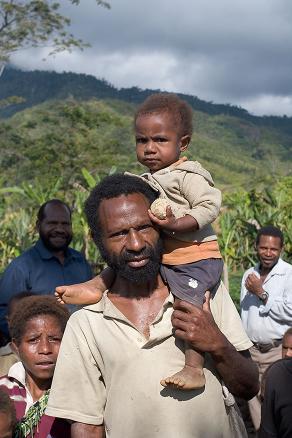
Anyway, it's time for us to leave (or else we're staying to eat the pig's blood), so off back
to the plane, and taxiing to the end of the runway for takeoff. A favourite game of the
kids is to gather at the end of the runway, and catch the prop backwash. I wonder how that
compares to an Xbox?


So now back flying through the steep ravines and between high mountains. We pass by another
village with an airstrip, and you can see why aircraft are the only way in or out of some of
these villages (except by foot). Some 4WD tracks exist, but in the wet they just get
washed away, and are rarely navigable.
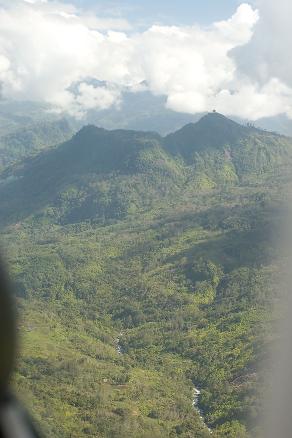
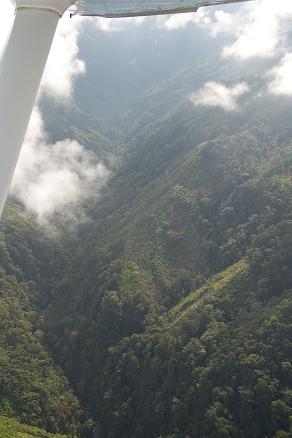
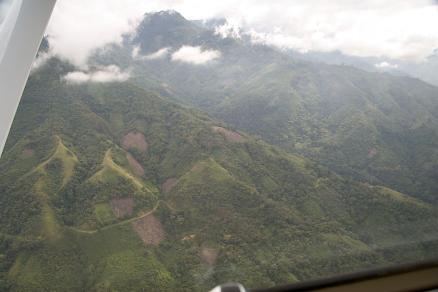
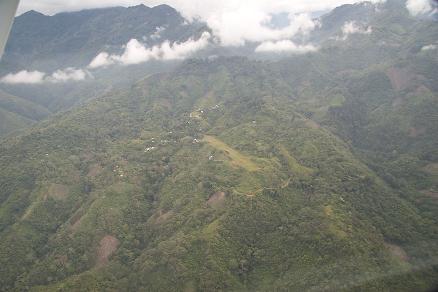
Prior to flying through the Kimil Gap, we overfly a wide unpopulated valley with several
rivers converging. We can see right down the valley, which eventually arrives at the Seepik,
in the Weewak area.

Flying through the gap, we enter the Waghi Valley, which looks positively civilised compared to
the country we have been in. And so ends my second flying adventure at MAF.

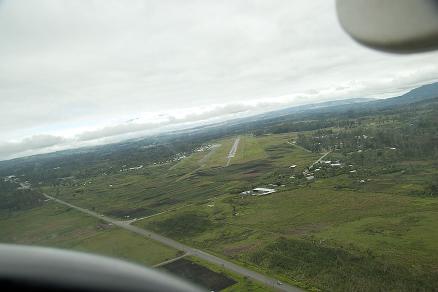
The rest of the day has prosaic stuff like Linux training, though at lunchtime
we have Fun With WiFi, installing and testing a point-to-point wireless link from the base to the
nearby compound (around 500m), so that the families on the compound can get direct
Internet access through the new satellite dish (since the base isn't used at night,
we can't let that all-you-can-use bandwidth just go to waste). Theoretically,
having Skype and other fast net access through the unused link would make a huge
difference to these families, given the cost of nearly AUD $1 per minute for
a phone call back to Australia. I say `theoretically', because PNG Telecom
claims a monopoly on all voice calls, just like Telecom Australia did about 30 years ago.
Before home computers. And the Internet. And Email. And VoIP.
I am starting to understand some of the intense frustration that the ex-pats feel living here. Anyway, I'm happy to do my bit, where I can.